This post – How to Cook Rice The Japanese Way – is all about the Japanese way of cooking rice. Preparing rice is one of the fundamentals of Japanese cooking. It is not boiled like pasta, it is cooked using the so-called absorption method. But there are more secrets to it.
I have included methods not only for cooking rice in a saucepan but also using a rice cooker in this post.
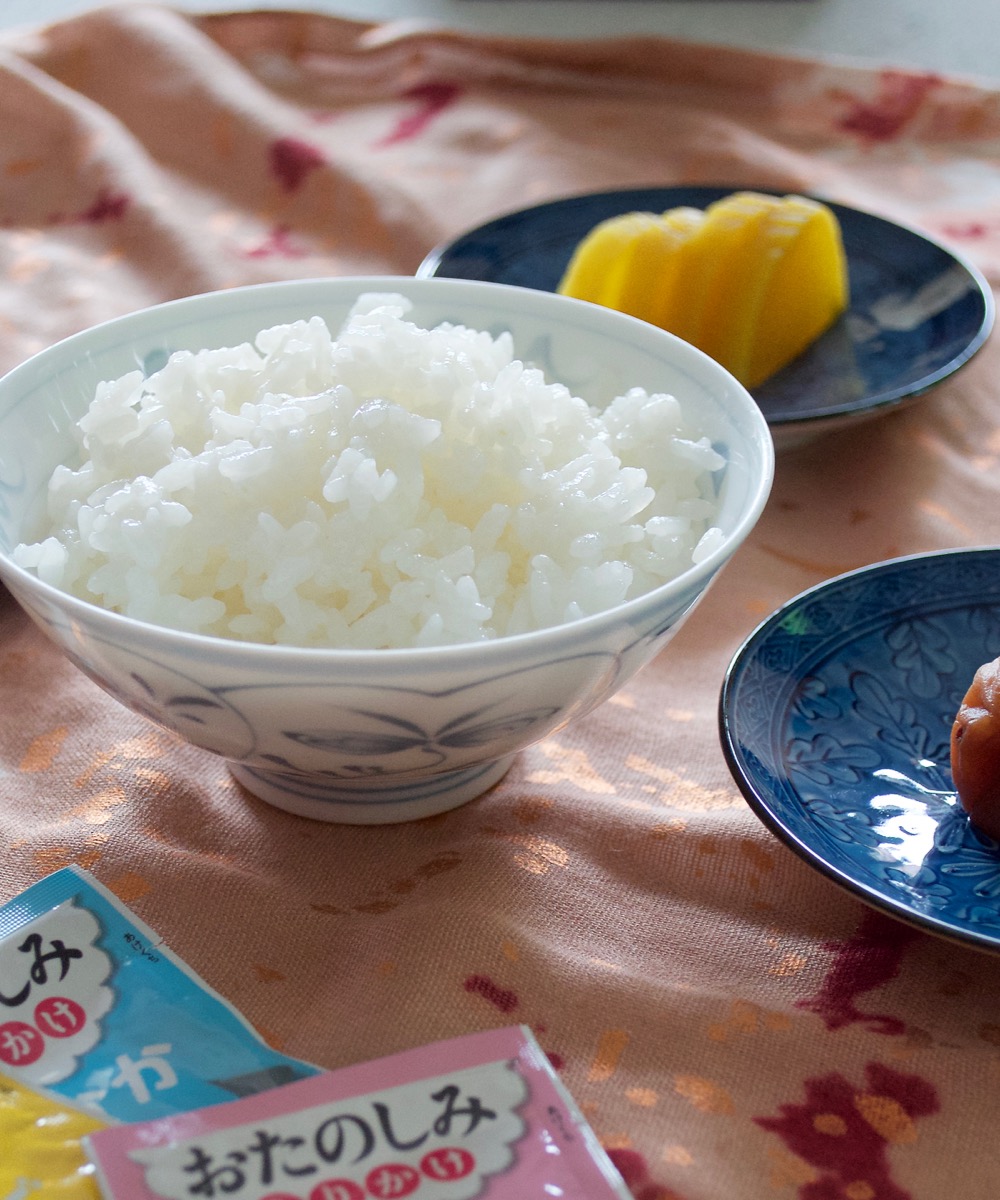
In Japanese culture, cooking rice (okome, お米) is almost an art. At home appliance stores in Japan, you will find so many different types of electric rice cookers on display.
About Rice in Japanese Cooking
Rice is one of the most important staple foods for Japanese people. People have a favourite brand of rice grain, and they strive to cook the best rice possible. Hence, most Japanese people have an electric rice cooker that will deliver consistent results.
Japanese rice is a short grain white rice that is fluffy and slightly sticky. Unlike long grain rice, including Basmati rice and jasmine rice, Japanese rice grains stick to each other when cooked. This is quite important because you can easily pick up a mouthful of rice with chopsticks.
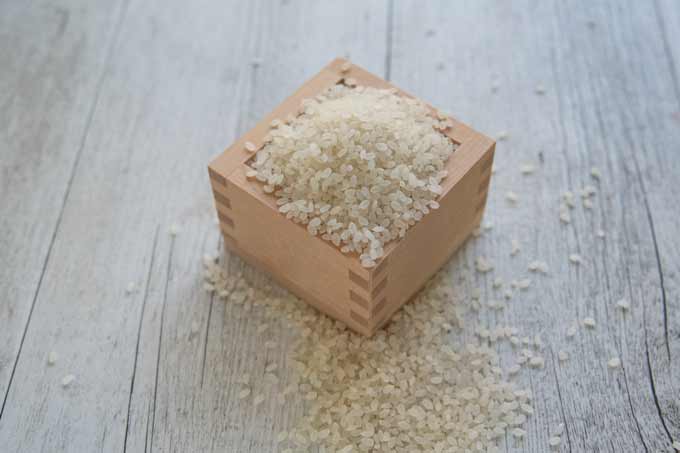
The brand of rice grain is also a critical factor. There are so many different brands from all over Japan as well as overseas and competition is fierce. Japanese farmers put a lot of effort into the pursuit of producing the best rice grain.
The high quality of rice however also means a high price. But many Japanese people say that they are happy to pay a lot for good rice, even if they have to buy cheaper side dishes to go with it.
Brands of Japanese Rice
If you are interested in trying Japanese rice, I would recommend the brand called Koshihikari (こしひかり or コシヒカリ). Koshihikari is one of the best brands of rice grain, noted for its sweet taste. It is the most popular brand in Japan.
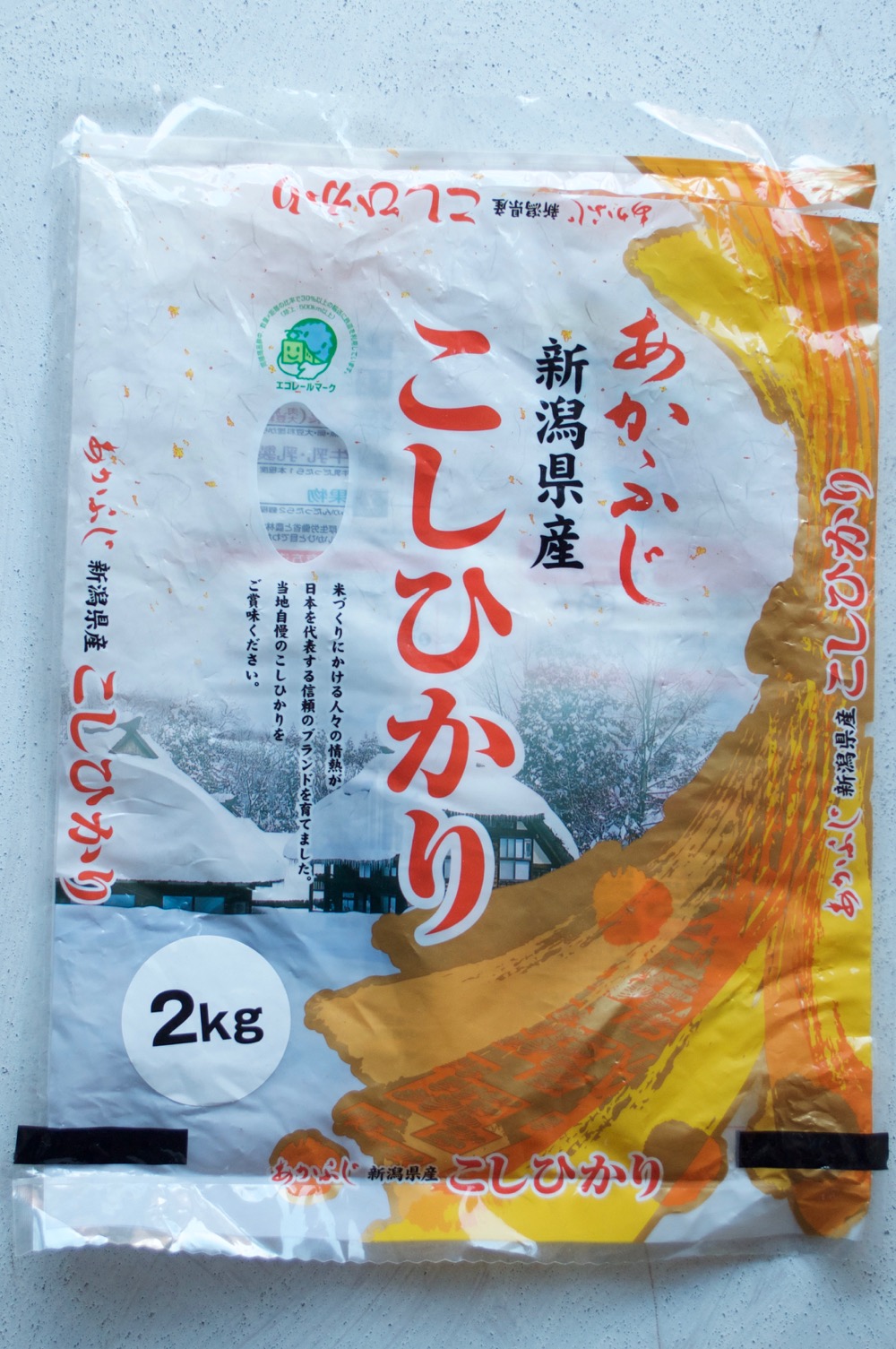
A bag of Koshihikari rice.
The Australian brand SunRice produces Koshihikari rice. You can even buy it at supermarkets these days.
From the original Koshihikari species, several new brands of rice were developed. They are Akitakomachi (あきたこまち), Hitomebore (ひとめぼれ) Hinohikari (ヒノヒカリ) and Milkyqueen (ミルキークイーン). Each of them has unique characteristics that are different from Koshihikari. You can buy some of these brands at Japanese grocery stores.
Another well-known rice brand that used to be neck and neck with Koshihikari is ‘Sasanishiki’ (ササニシキ or ささにしき). Unfortunately, Sasanishiki rice suffered from the extreme cold weather from 1980 to 1983 and the farmers had to reduce production of Sasanishiki rice significantly.
Sasanishiki (left photo below) is known to be best suited for sushi and sushi chefs in Japan are fond of this brand. As mentioned in my post Take Away Sushi Rolls, Sasanishiki rice is less glutenous than other species, so the sushi rice does not become sticky when sushi vinegar is mixed. You can still buy Sasanishiki rice at some Japanese/Asian grocery stores.
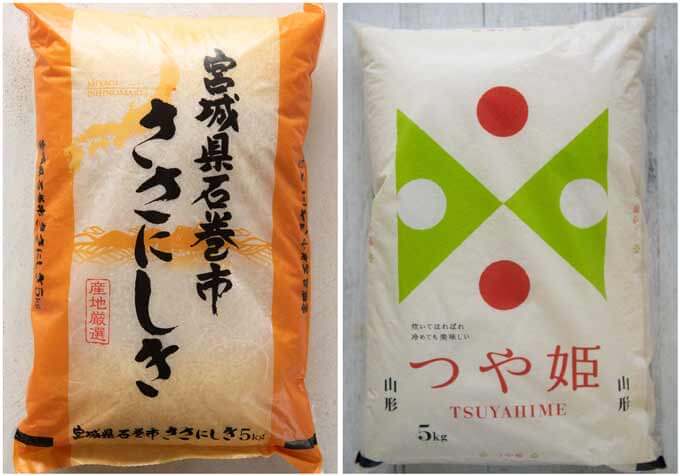
I sometimes buy the new rice brand called Tsuyahime (つや姫) at a Japanese grocery store (right photo above). The cooked rice is whiter and shinier than other brands. In addition to the appearance, it has a good balance of sweetness, umami, and stickiness. It was developed from the mutant of Koshihikari that was found 4 generations earlier.
The Japanese Way of Cooking Rice
Firstly, please do not cook Japanese rice in the same way as cooking pasta. I know that many Aussies simply boil cook their rice in a large amount of boiling water. It gave me a shock when I first learnt this. If you want to cook this way, please do not use the Japanese brand rice.
You can cook rice the Japanese way in a pot/saucepan on a cook top or in an electric rice cooker.
Cooking Rice in a saucepan on cook top
If you need to cook rice in a pot and want to make it just like the Japanese do, please follow the step-by-step instructions in the recipe. It might not look like as simple as you think, and you might wonder if you should be bothered making this much effort just for rice. But once you get used to it, it’s a simple process and you will never want to boil rice like pasta anymore.
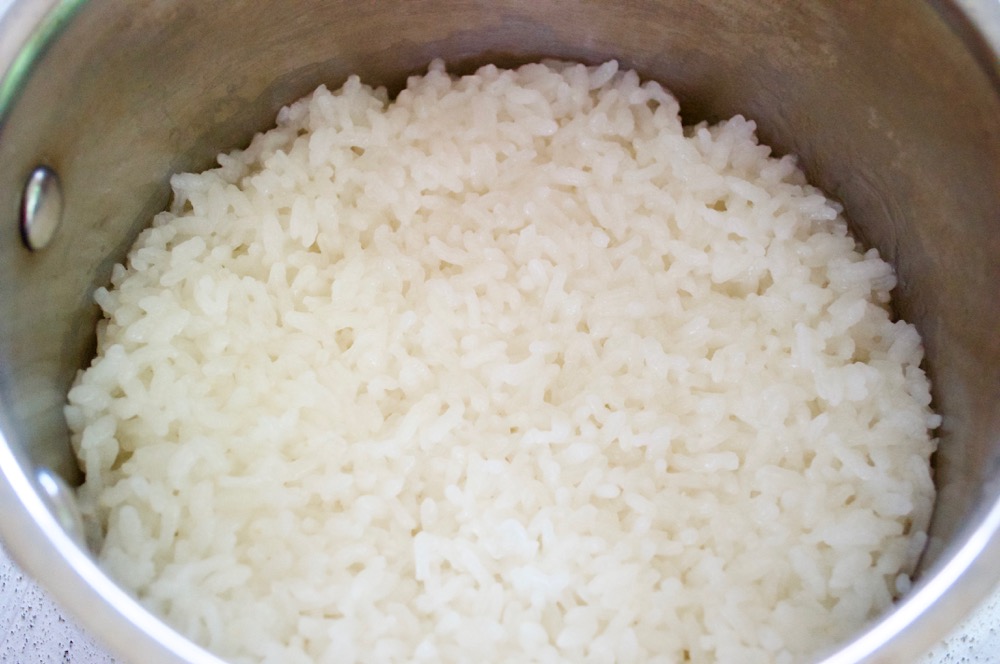
The key points are:
- Wash rice well – the powder around the rice makes the rice stickier.
- Soak the rice in water to let the rice grains absorb water – to cook rice evenly to the core of the grains.
- Rest after the heat is turned off – to make the rice fluffier.
- Mix the rice by turning the rice over from the bottom – to let the excess moisture evaporate.
Cooking Rice in a Rice Cooker
A rice cooker should come with a measuring cup. It is best to measure the rice with the cup provided.
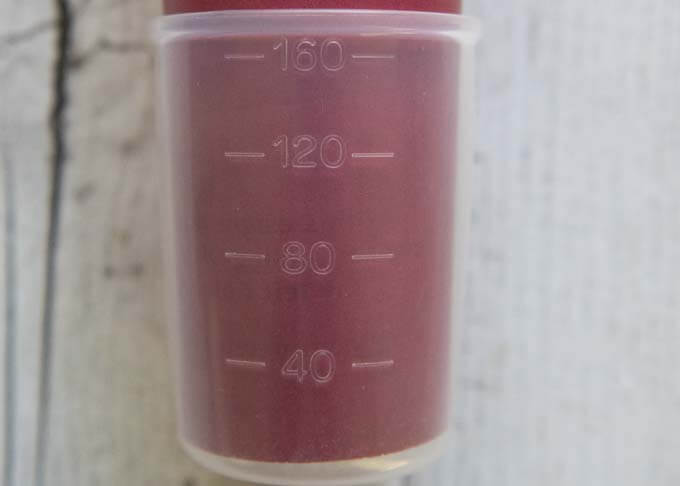
The capacity of the cup is 180ml / 6.1 fl oz, which is much smaller than the standard measuring cup. It is an odd volume as a metric unit, but it is not so odd if you think about the history of Japan. The next section explains the reason for it.
A rice cooker comes with an inner pot that goes inside the rice cooker. You will see the lines and numbers marked on the inside of the inner pot. These numbers indicate the water level required for the corresponding number of rice measuring cups. For example, if you are cooking 2 cups of rice, fill water to the line marked ‘2’, with the rice in it.
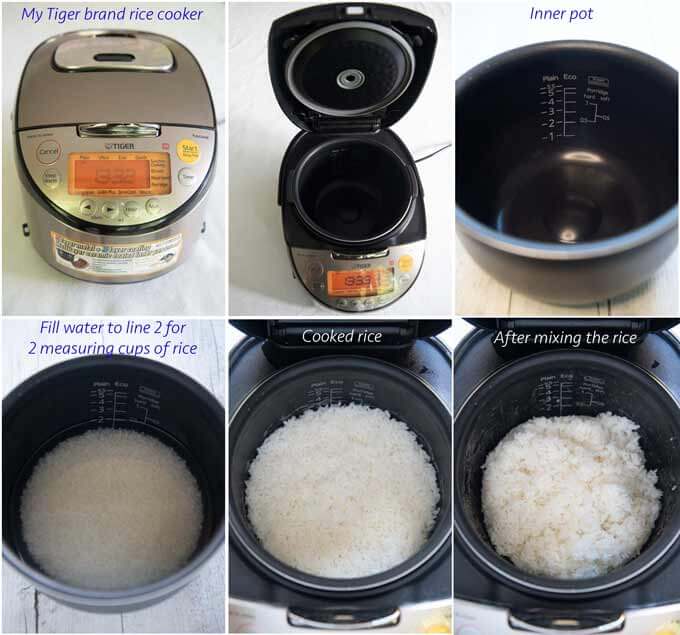
Even if you are cooking rice with a rice cooker, the 4 key points that I listed in the previous section applies. But if your rice cooker includes the water absorption time and the resting time in the cooking process, only the first and last key points apply.
Because you simply add water to the level indicated on the pot, there is no need for you to accurately measure the amount of water to put in the pot. So, I usually wash rice in the inner pot, add water to the required level, then turn the switch on.
Why is the rice measuring cup 180ml / 6.1 fl oz?
The capacity of 180ml comes from the old Japanese unit of measuring volume called ‘gou‘ (合). Until the Meiji Restoration, which ended the Edo period, Japanese people were using their own units to measure volume.
Gou is the second smallest unit. Instead of a plastic cup (as there was no such thing as plastic), people used a square wooden cup, which is almost equivalent to 180ml (180.39ml to be exact). The next level of unit is ‘shou‘ (升), which is 10 times of gou. 10 times of shou is ‘to‘ (斗, pronounce as /tɔ/ – the sound of toy without ‘i’), then 10 times of to is ‘koku‘ (石).
Traditional Japanese wooden measuring cup is called ‘masu’ (枡).

The volume of the small wooden measuring cup is 1 gou masu (about 180ml), the large cup is 1 shou masu (about1.8L).
In the Edo period, the farmers had to pay their tax to their feudal lords by way of supplying rice. So the prosperity of the feudal lords was expressed by the amount of rice, using the largest unit ‘koku‘ (石).
As part of the Meiji Restoration, the government replaced the old Japanese measurement units with the current metric system. But even now the old volume unit is still used for measuring rice.
Interestingly, the large bottle of Japanese sake is 1.8L / 3.8pt and people still call this bottle ‘isshōbin‘ (一升瓶), which means 1 shou bottle. Some Japanese restaurants serve cold sake in a skinny glass placed inside an ‘ichigou masu‘ (一合枡, 1 gou wooden measuring cup) – the small wooden cup in the photo above. Sake is associated with rice after all.
Japanese Etiquette when eating rice
If you would like to serve cooked rice (gohan, ご飯) the Japanese way, you will need a small bowl specifically made to serve rice called ochawan (お茶碗). As an alternative, you can serve the rice in a small ceramic bowl with a foot (i.e. base) so that you can hold the bowl without your fingers getting too hot.
You hold ochawan with one hand by placing the foot of the bowl on four fingers and the thumb on the rim, and hold chopsticks (箸, hash or お箸, ohashi) on the other hand (see the photo below). Yes, you do lift the bowl when eating rice. In fact, if you eat rice out of the bowl without lifting it from the table you will be considered to be lacking etiquette.
To eat the rice from the rice bowl, use your chopsticks and pinch a mouthful of rice, lift and move the chopsticks to your mouth. Placing the rim of the bowl to your mouth and sliding the rice into your mouth with chopsticks is considered to be bad manners.
In this recipe, I have included some typical condiments that Japanese people eat with rice to give it flavour. See the photo below – rice with umeboshi (梅干し, the pickled plum in the top right of the rice bowl), takuan (沢庵, pickled radish, yellow) and tarako furikake (ふりかけ, cod roe flavoured rice seasoning). You can just eat rice with these toppings without any other dishes.
Yumiko![]()

Originally published in August 2016. Added a recipe for cooking rice in a rice cooker, and improved photos and contents (no change to the original recipe).

The Japanese way of cooking rice takes time, but the cooked rice is fluffier than it would be if you used the boiling method (it will not be soggy). Once you master it, you will not want to cook rice any other way!
The prep time does not include soaking time which varies depending on the season.
- 1 cup short grain or sushi rice (Note 1)
- 1 cup + 2-3 tbsp water (Note 2)
- Furikake (Cod roe flavoured rice seasoning)
- Umeboshi (Pickled plum)
- Takuan (Pickled white radish)
-
Accurately measure and place the rice in a large bowl. Add enough water (not in ingredients) to cover the rice and wash gently, then discard the water. Repeat the process 4-5 times until the water is almost clear.
-
Leave the rinsed rice in the bowl and add enough water (not in the ingredients) to cover the rice. Leave the rice to soak for 30 minutes (summertime) to 1 hour (wintertime). (Note 3)
-
Using a sieve, drain the rice and remove as much water as possible.
-
Place the rice in a saucepan with a heavy bottom and add water (per the ingredients list). Cook over medium heat with a lid on.
-
When the water starts boiling and bubbles come out of the pot, reduce the heat to low. Cook for 12-15 minutes until there is no water at the bottom of the pot or you don’t hear a bubbling sound from inside the pot. Do not open the lid while cooking.
-
Turn the heat off and leave for at least 10 minutes with the lid on. Then mix the rice using a rice spatula (if you have one). This is to remove excess moisture within the cooked rice grains. Also the rice does not to mould into the shape of the pot at the bottom.
-
Furikake (ふりかけ) is a dried Japanese seasoning that is sprinkled on top of cooked rice. Ingredients include a combination of dried fish flakes, dried egg, dried cod eggs, bonito flakes, sesame seeds, chopped seaweed and other flavourings.
-
Umeboshi (梅干し) is a salty and sour pickled plum. There are brown umeboshi (natural colour) and red umeboshi (dyed using purple perilla). Large umeboshi are about 2-3 cm (¾-1¼") diameter and have a very soft texture, while tiny umeboshi are normally crunchy. The seed inside an umeboshi is very hard and you should not eat it as you might break your teeth.
-
Takuan (沢庵) is one of the many pickled vegetables that Japanese people love. Unlike some of the western-style pickling, Japanese people do not use oil to pickle vegetables. They typically use any combination of salt, soy sauce and vinegar.
1. Short grain or sushi rice are the closest types of rice to Japanese rice. You could use medium grain, but long grain or any other rice grains are not suitable. I buy Japanese short grain rice called ‘Koshihikari’ (こしひかりorコシヒカリ). I like it because the cooked rice is fluffier and shinier than other types. In Australia, you can buy Koshihikari at most Asian grocery shops and definitely at Japanese grocery shops.
2. The amount of water required depends on your preference for the cooked rice (al dente vs soft), age of the rice grain (new rice needs less water), and the pot you use (more steam evaporates with a wider pot). You will need to experiment and work out the exact amount that suits you.
3. This is a traditional way of cooking fluffy rice. You will see that each grain becomes white after absorbing the water. If you don’t have time to soak the rice in the water, you can cook it straight away. In this case you might need to increase the amount of water slightly when cooking the rice.
4. If you are using the rice for sushi, placer a pice of konbu on top of the water, then cook rice. The rice will absorb umami from the konbu.
5. Leftover rice can be kept in the fridge for a few days or in the freezer. Use the microwave to thaw and re-heat.
6. Because of the strong flavour of these condiments, Japanese people sometimes eat rice with just these when they are in a hurry or just to fill themselves up without going through the hassle of cooking a meal.

A rice cooker should come with a measuring cup. The capacity of the cup is 180ml, which is much smaller than the standard measuring cup. It is best to measure the rice with the cup provided.
The time taken to cook rice varies depending on the cooking option selected. I have indicated the longest cooking time (includes water absorption and resting time) on my Tiger brand rice cooker.
- 2 rice cooker cups of rice (180ml x 2 / 6.1 fl oz x 2)
- Water
-
Remove the inner pot from the rice cooker and put the rice in the pot.
-
Add enough water to cover the rice and wash it gently, then discard the water. Repeat the process 4-5 times until the water is almost clear.
-
Add water to the line marked ‘2’ on the side of the inner pot. Shake the pot gently and level the surface of the rice. (note 7)
-
Wipe off the water around the outer surface of the inner pot and place it in the rice cooker.
-
Leave it for 15 minutes to let the rice absorb water (note 2).
-
Turn the switch on.
-
When the rice cooker completes cooking, let the rice rest for 10-15 minutes with the lid on (note 3).
-
Using a rice spatula (note 4), mix the rice by turning the rice over from the bottom, then mix (note 5). This process lets the excess steam evaporate, preventing the rice from getting too sticky.
1. Measure the rice using the cup that came with the rice cooker. If you lose the cup, use a measuring cup and measure 360ml / 12.2 fl oz of rice.
2. This step is required only if your rice cooker is a very simple rice cooker with no menu options, or you are using the Quick Cook option on more advanced rice cookers. Advanced rice cookers that take 50-60 minutes to finish cooking (standard cooking option) includes the water absorption time.
3. This step is required only if your rice cooker is a very simple rice cooker with no menu options, or you are using the Quick Cook option on more advanced rice cookers. This is called the steaming process and it allows the excess moisture in the pot to evaporate. Advanced rice cookers that take 50-60 minutes to finish cooking includes the steaming process.
4. A plastic rice spatula usually comes with the rice cooker. But if don't have one, use a plastic/wooden round spatula. Never use a metal spoon if your inner pot has a non-stick coating.
5. It is easier if you make a cross on the surface of the rice and turn ¼ of the rice at a time to turn over and mix.
6. When the rice is cooked, the rice cooker should switch to 'warm' mode to keep the cooked rice warm. It is recommended not to keep it warm for more than 5-6 hours to maintain the quality of the cooked rice.
You can leave it warm for 12-24 hours, but the rice becomes dry. The flavour also degrades. It is better to take the rice out of the rice cooker and keep it in the fridge or freeze it.
7. If you are using the rice for sushi, placer a pice of konbu on top of the water. The rice will absorb umami from the konbu.

Hi !! It is so great to finally found a proper and detailed recipe for this type of rice. May I know how nutritious it is compared to other types of rice?
Hi, I don’t hae the comparison details at hand but I found the site below which might give you some information.
https://www.calorieking.com/us/en/foods/b/calories-in-average-all-brands/cuNNkJVjRDOOxMUYAdBjMA?classification=Rice
Thankyou Yumikofor such an interesting and detailed article on rice and cookers, upto now I have never seen the use for a rice cooked, but you made some very I interesting points. I do like the Tefal products so might have to check out their rice cooker…
Hi Lindi, if you like cooked rice, you will not regret having a rice cooker in your kitchen!
Hi, Yumiko. Thank you for this great article. Can you please educate us on the different uses for short or medium grain rice vs sweet rice? Thank you!
Hi Dianne, next time when I post a dish using sticky rice, I will include an article about short/medium grain rice and sticky rice.
Great info on cooking rice written with such detail! Thank you.
Any recommendation on which Tiger rice cooker to buy? There are a few advertised..
Hi Poornima, Induction Heating rice cooker cooks rice best. If you have a choice of the thickness of the inner pot, the thicker one is better but the price is dearer. IH rice cooker is not cheap but micro computer controlled rice cooker is also good. I think the cheapest model does not look like my tiger rice cooker and it is produced specifically for overseas customers. It has the simplest features but it still works well. If you only need to cook rice, then the overseas model. might be good enough. If you would like to experience fluffy well cooked rice and play with different options, go for the more expensive models.
Thank you so much!
This may be a stupid quiestion, but do you add the water cold to the rice when you start to cook it, or hot? And does the time it takes to boil count towards cooking time?
Hi Jack, add cold tap water. During the process of bringing the water to a boil, the rice grains start getting cooked slowly.
If you are asking about Cook Time indicated at the top of the recipe card, it should include the time to bring it to a boil. Having said that, Cook Time looks too short if I also include the resting time. I update the recipe card to have the resting time as a seperate line. Thanks for asking.
Hello, i am curious if you have any certain brands of rice cookers that you might recommend?
other then cooking from a pan, is there any difference with a cooker? taste? etc?
and from my understanding, you are blanching the rice first before cooking it? much like blanching potatoes to remove the starch? I’ve never tried this before, but i would have to assume it removes the fatigue feeling and adds quality?
Sorry for the questions, just intrigued.
Hi LilShipppo, I have a Japanese rice cooker. I once used a locl-brand rice cooker but I think the Japnese brandm, such as Tiger or Panasonic would be better. Mine is Tiger. The rice cooked in the rice cooker is fluffy and the end results are consistent.
I don’t blanch rice beforehand. But I do wash the rice well until the water becomes clear.
Zojirushi!! Been using their products for more than 50 years! Never, EVER had an issue with their products…especially rice cookers.
Just wish they would bring their rice pounding machine for making mochi to the USA using 110v/60hZ power.
Aslo important to note that many rice brands say “Prewashed”, but that is different from washing the rice until the water is clear, which should still be done. (Some rice cookers have a “prewashed” setting that changes the cycle just a bit.
Always enjoy your site, Yumiko! Gambate!
Hi Frank, arigatou gozaimasu.
Zojirushi is also a good brand, so is Panasonic. I have never seen the rice labelled as pre-washed.
Hello Yumiko, I always cooked rice on the stove and did not like the end result. I bought myself a Tiger rice cooker, few years back and absolutely can’t live without it. I loved your detailed recipe for cooking rice. So thank you .
Hi Diane, yes, a rice cooker is a life saver! I can’t live without it. Tiger is a good brand.
I feel like any time I try to cook rice like this, it always ends up a bit sticky or slimy. No matter how much I rinse the rice, it always happens.
Do you have any advice for what I may be doing wrong?
Also when making rice for sushi, is it appropriate to add rice vinegar? If so, how much?
Hi Derrick, I am sorry that your rice is not quite right. It sounds like the amount of water is a bit excessive in your case. Depending on your pot, stove and your palate, the firmness of the cooked rice can vary. Experiment with reduced amount of water.
You don’t add vinegar when cooking rice for sushi. You cook rice with a sheet of konbu. As soon as the rice is cooked and ready to use, mix in the sushi vinegar which consists of rice vinegar, sugar and salt. Any of my sushi recipes (e.g. Take away Sushi Rolls) gives you the proportion of these ingredients to make sushi vinegar and the amount required for the quantity of cooked rice.
I feel like I should clarify. I was not using YOUR recipe when I messed up. Just a similar one. (I’ll be using yours in the future!)
And yes it appears I was using twice the amount of water needed. I’ll try again soon.
Thank you very much for answering. I’m very happy to have found your website!
Good luck with the new method!
The small sheet of kombu on top of the water to start when cooking rice is the GREAT secret to adding a bit of perfect umami flavoring to the rice.
I learned this from sushi chefs in Japan…and here in the USA, virtually no one knows this!
Hi Frank, it is common to add a piece of konbu when cooking rice, if you are making sushi rice. I mentioned in the note section of the recipe card: Take Away Sushi Rice. Maybe I should add in this post. Thanks for mentioning.
Hello, if you use a rice cooker do you still let the rice soak?
Also I’m having trouble finding a japanese rice cooker in my country, is there any foreign brand you could recommand?
Best regards!
Hi Jules, yes I do. I think the cooked rice becomes fluffier. I am not familiar with non-Japanese brand but I read in a couple of Japanese articles that Tefal rice cooker is very similar to the Japanese rice cooker.
Great, thank you for your answer!
Hello there. What are you choices/thoughts on a dedicated rice cooker appliance. I am looking at a lot of varieties at the big box store. Also, using chicken broth to cook the rice. Do you like broths or just stick with filtered water.
Hi Amanda, I am a fan of Japanese brand rice cooker. At the moment, I use a Tiger brand rice cooker with a thick cooking bowl which goes inside the rice cooker. The thick bowl cooks better rice, but it’s more expensive.
I usually cook rice with plain water, unless I make mixed rice with flavouring, in which case, I usually add dashi stock and some other flavourings. Cooking rice with chicken broth would be good particularly when the main dish does not have a strong flavour.
Can I / should I put salt in the rice if it’s being eaten alone or is plain fine?
🙂
Hi Oj, good rice has sweetness and you can taste it. If you like a very light flavour, you may find it OK to eat plain rice without any flavouring. But if you need a bit of flavour, salt would help. If you don’t mind having slightly brownish colour of the rice, I’d strongly recommend cooking rice in dashi stock and some soy sauce (instead of plain water). They add umami and salty flavour to the rice so, you can eat it by itself. Some restaurants serve the rice like that.